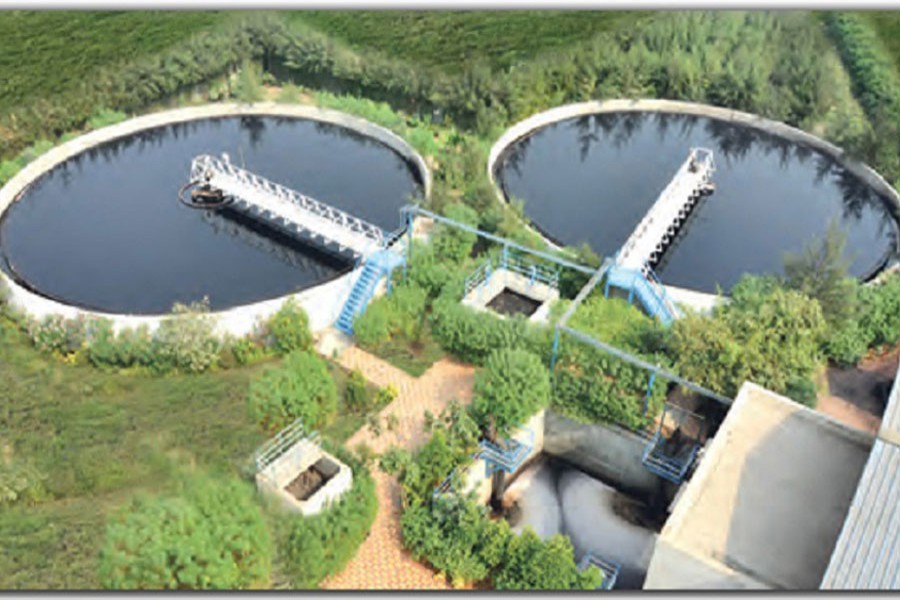The government is reportedly going to allow construction of effluent treatment plants (ETPs) by individual tanneries at the Savar tannery estate. For those who are aware of the government's commitment about a Central Effluent Treatment Plant (CETP) at the tannery estate and also about the works going on there for long six years, the news is sure to surprise all, the stakeholders in particular. For long the authorities have been assuring the tanners about completion of the CETP, and now, still not shying away from more such commitments, they are set to allow the tanners to build their own effluent plants!
Ever since the relocation of tanneries from Hazaribagh to the Savar estate years back, commitment did keep pouring in about work completion. Although there were some moves to speed up progress of work including initiatives to recast some critically technical aspects of the plant pertaining to the disposal of liquid and solid waste, nothing actually came up to rescue the tanners from being shunned by overseas buyers due to the lack of required compliance-- which could have been addressed by proper functioning of the CETP.
It may be noted that for export purpose, it is the certification of the Leather Working Group (LWG) that can fulfil the compliance norms. The UK-based LWG comprises many relevant stakeholders including brands, retailers, product and leather manufacturers, chemical and machinery suppliers, technical experts and other service providers that work together to maintain environmental protocols, specifically for the leather manufacturing industry. Obtaining certification from the group is thus a prerequisite for any country to sell leather and leather goods at international markets. In the absence of compliance and LWG certification, major global buyers, especially the European and American, do not procure goods from non-compliant factories. This clearly points to the insoluble hurdle that Bangladesh's leather and leather goods exporters are now faced with as they are yet to be certified by the LWG. It is here that CETP emerges as the foremost requirement for leather and leather goods producers in exporting their products.
It has been learnt that a good number of international buyers who used to procure leather and leather goods from the country have moved to other exporting countries. Respective country-compliance norms of importing countries and increasing international pressure not to procure from environment-unfriendly sources (like the Savar estate, as it is now) have left very few choices for exporters here to access overseas markets.
In this situation, our manufacturers are left with no choice but to sell tanned leather to some Chinese companies at rates well below international prices. The question here: who is to blame? Not the exporters. Nearly 155 tanneries have reportedly invested Tk 70.0 billion to set up their relocated factories employing around 50,000 people.
The CETP at the Savar estate is a classic case of indifferent government action that often hinges, according to sector experts, on lack of knowledge and experience in going about a project such as this. The groundwork for the CETP started in 2014 and it was supposed to be completed by 2017. Work got delayed several times, and the reasons for delay clearly explain how ill-prepared the authorities were while taking up the massive task. The project was plagued by frequent change of project directors, fund constraint, legal problems, bureaucratic tangles and delays caused by Chinese contractors. So far, Tk 8.79 billion has been spent on the CETP, reports a local daily quoting the project director of the estate.
Although it sounds rather harsh that the country's leather sector is dwindling, the fact remains that aimless moves made worse by absence of proactive plans, have already dug deep ruts on its path of becoming what it was meant to be. Leather is one of the country's key export products. But despite its immense growth potential, it has not been able to shine at all but for tiny blips. Some late-entrants like Vietnam and Cambodia are doing far better in this sector. Vietnam's export, for example, now stands at $20 billion a year, while that of Bangladesh shockingly hovers well below $1.0 billion in recent years.
The leather sector over the years has suffered more misery than any other in the country due to sheer insensitivity and negligence of the authorities. The problems in exporting that have been emerging in recent times causing drastic decline are for the most part attributable to government's indecisions, even grossly wrong decisions. Not to speak of proactive plans, the long sequence of events -- including the many twists and turns -- around the tannery hub relocation from Hazaribagh to Savar, the limping progress of work of the estate in general, and last but not least the infamous CETP brings forth the dismal narrative of the country's leather sector.
It is not known how things are going to look like in the near future. The President of the Bangladesh Tanners Association has reportedly said that setting up individual ETPs by the tanners would cause a serious monitoring and coordination problem. What is more worrying is that there prevails an uncertainty over the fate of the CETP. The authorities should talk to the stakeholders before taking any further move.


